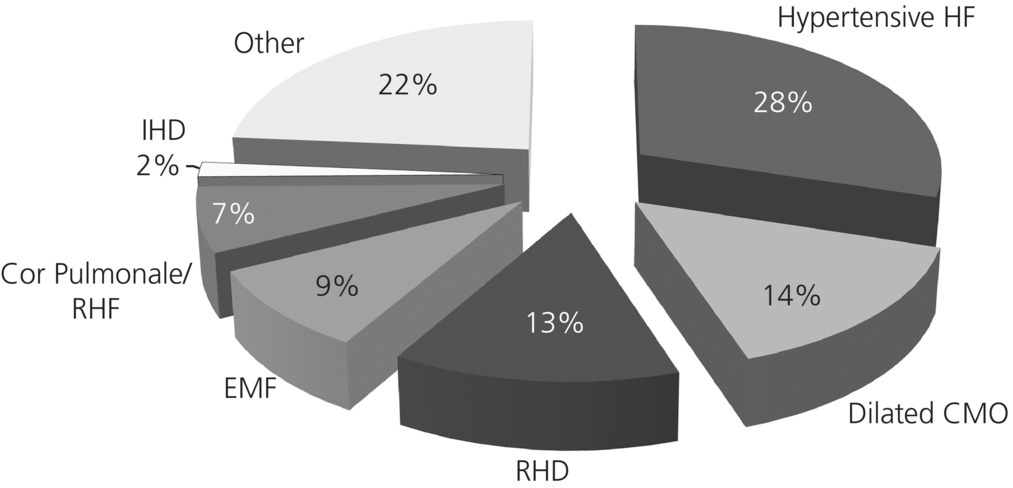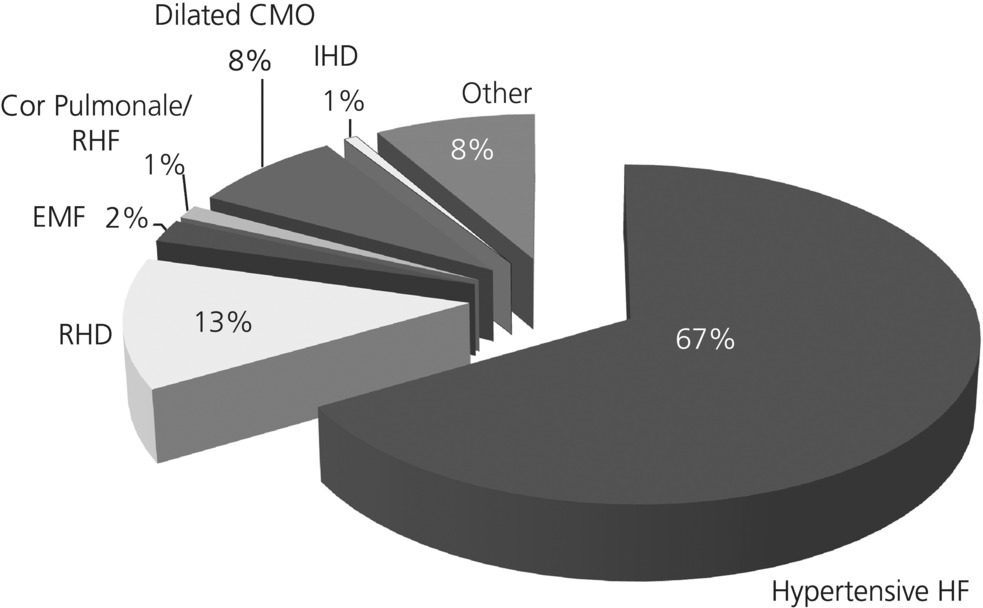SECTION 6
Heart failure
S6.1 The many faces of HF in Africa
In this section of the book, the various manifestations of HF in the sub-Saharan African context are presented, providing an important counterpoint to that presented from a Western, high-income perspective. Despite some controversy over the true spectrum of HF in high-income regions of the world including Europe and North America, due to the influence of clinical trials and registries reporting from specialist cardiology centers (perhaps with a natural focus on middle-aged men presenting with an ischemic CMO), it is clear from whole population data that HF predominantly affects men and women alike beyond the age of 65 years and is a major cause of morbidity and mortality [1–5]. In recent years, the rate of incident HF admissions has declined and the overall rate (per head of population) has plateaued and even declined in some age groups; with notable shifts in the pattern of HF-related morbidity due to CAD associated with heart failure with reduced ejection fraction (HFrEF). These trends are counterpointed by an increasing number of heart failure with preserved ejection fraction (HFpEF) cases associated with uncontrolled hypertension in older individuals (particularly women). We know this because of an early recognition that HF posed a significant threat to aging populations in whom antecedent risk factors remained high, but the risk of dying prematurely from an AMI was declining [3,6]. In simple terms, the “Cinderella” of heart disease was no longer being ignored and has been closely monitored for more than two decades.
The temptation, of course, is to assume that epidemiology and subsequent treatment of HF derived from large-scale clinical trials will apply uniformly across the globe. However, in the sub-Saharan Africa context, this would be a mistake. As described by Falase and Ogah [7], the predominance of CAD and its chronic manifestation ischemic CMO in the Western world was contrasted by historical lows in Africa. For more than 50 years the pattern of HF in Africa was remarkably stable with hypertensive HF an important but nondominant contributor to HF cases, given the contribution of the dilated CMOs, RHD, EMF and cor pulmonale/RHF. These conditions reflected a combination of infectious and genetic pathways to the syndrome. As described in Section 1, cases of PPCMO among young African women remains an ongoing and significant contributor to HF cases in Africa. At the same time, the typical ischemic CMOs seen in the Western world and the subject of clinical trials feeding the evidence base to improve typically poor survival rates and prevent progressive cardiac dysfunction/recurrent episodes of acute heart failure (AHF) remained scarce in those of African ancestry. Overall, however, HF cases were relatively rare in sub-Saharan Africa, at least from a reported and research perspective. The following chapters quickly dispel the myth that HF is rare in Africa. Indeed, there are now many pathways (both communicable and noncommunicable) to the syndrome, and these pose an increasing challenge to resource-poor health care systems throughout the continent.
S6.1.1 Geographical context
The final section of this book spans several regions of the continent, commencing with the twelve-country THESUS-HF registry and concluding with the four-country Pan African Pulmonary Hypertension Cohort (PAPUCO) registry. Chapter 12 introduces us to Abeokuta, a Nigerian city that also features in Chapters 13 and 14, while the Nigerian capital, Abuja, is highlighted in Chapter 13 (for a country-level profile of Nigeria, refer to Section 2). Cameroon (see Section 2) is revisited in Chapter 14, and Chapter 13 includes a final return to South African Soweto (see Section 1).
Abuja, the capital city of Nigeria, is reported to be the fastest-growing city in Africa, with an urbanization rate of 8.32% per annum [8,9]. With over 3 million permanent residents, Abuja’s daytime population often reaches 7 million [9,10]. The consequence of this rapid growth and urbanization is that the city’s administration is struggling to manage the increasing difficulties of providing basic housing and public services [9]. Despite a national health care system, the level of overall government contribution to health services is low, and private out-of-pocket payments compose almost 70% of costs [11]. A lack of human and technical resources, particularly in maternal health [12] and specialty areas such as cardiology [11,13] contributes to health outcomes that do not match the region’s economic growth [13].
Abeokuta is the capital city of Ogun State, located in southwest Nigeria. Currently estimated at approximately 1 million individuals, the population of Abeokuta is rising rapidly [14,15]. The majority of residents do not have access to social health insurance, and health care costs are typically borne out of pocket [16]. However, strong family ties ensure that poorer patients are generally assisted by wealthier relatives [16]. The Federal Medical Centre in which the Abeokuta-based studies featured in this book were undertaken is the only tertiary hospital in the city, receiving referrals from across the city and state as well as from neighboring states [16].

S6.1 Major causes of heart failure presentations in Nigeria in the late 1960s.

S6.2 Major causes of heart failure presentations in Nigeria in 2010.